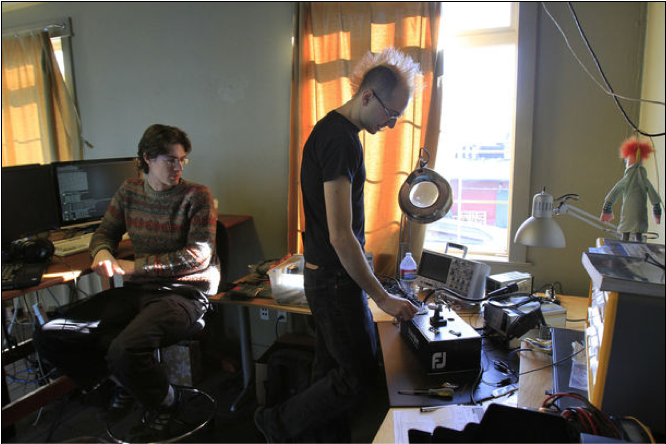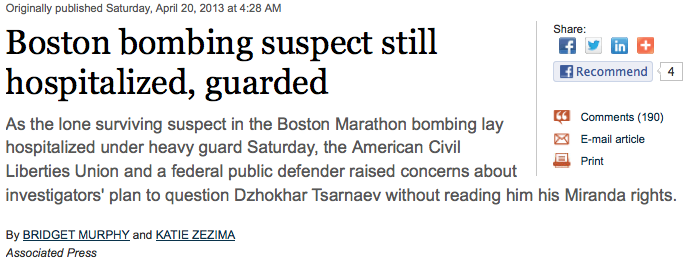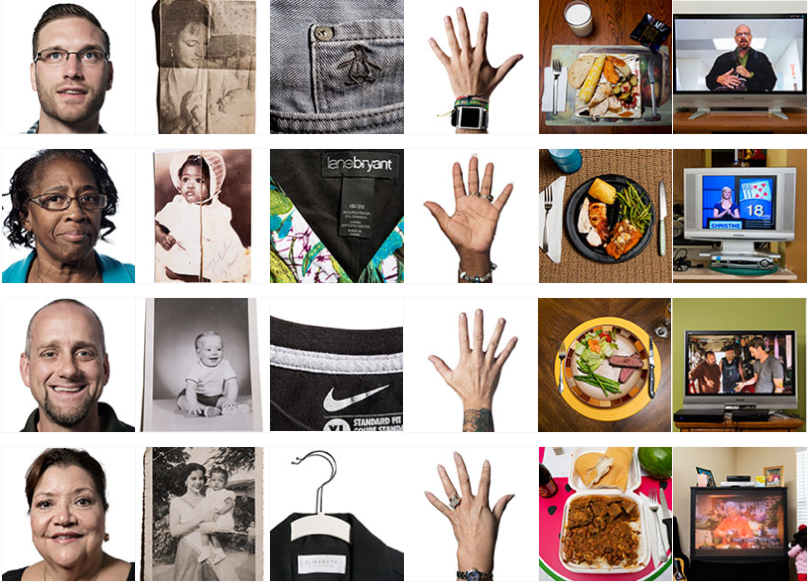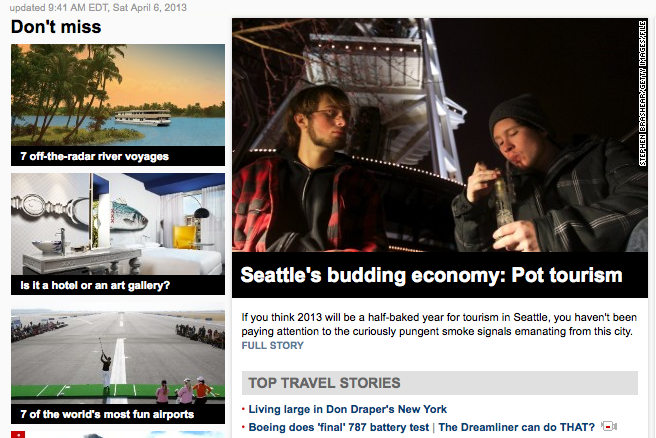
photo courtesy Mark Harrison/The Seattle Times
Three hours ago I was resolved not to talk about market trends in this post. This is supposed to be an overview of what I think of The Seattle Times, after all, and I've spent a lot of time talking about how a refocus on local stories probably saved the paper from going the way of the PI in 2009. Again, that was all three hours ago. My feelings have changed. What happened three hours ago was the publishing of an amazing article by Erik Lacitis on "white hat hackers," computer geniuses who try to break down programs and hack systems to find the security flaws. The piece profiles Leviathan Security Group, a technology security company specializing in internet security. It uses the story of one of the hackers at the company, and the company itself, to describe how the internet security industry is booming, worth around $1 billion last year. About three-quarters of the way into the article I realized two things. First, this was really good writing. I had just read an entire article on a guy who hacked computer systems for security purposes and accidentally learned a lot about the industry this character was in. The second thing I realized was this article was published online at 8 p.m. on Sunday night, which means it probably got cut from the Monday morning print edition. Whoa. I've spent a lot of time in this blog talking about how market trends dictate the way the news is reported. An inability to compete nationally forces papers to take on a regional focus. A need for supplemental elements to a print story dictates that seasoned reporters learn video. Web traffic dictates what the biggest stories are online as much as editors do theses days. However, there is one thing that cannot be changed within the industry, cannot be affected by market trends, cannot be changed by the short attention span of the online media consumer, and that is good reporting. The Times is built on a base of strong reporting. At the end of the night I don't particularly care what video is attached to what story. Is it nice to have a visual supplement to an article? Absolutely, but its not necessary. The one thing that will turn me off to a story faster than anything else is if the reporting seems thin. I can't stand it. If there is no substance than there is no reason for me to stay on a page longer than 5 seconds. I have never once felt that an article I opened on The Times website lacked substance. It has been the best beat I've covered so far i any of my media blogging experiences. Long live The Times and
 The Seattle Times cherry picked the AP wire for coverage. Yes, I wrote about it too. With a TBD blog post, I'll make a bet that 14 out of 18 members of #loweclass focus their blogs on the Boston bombing that has captured the nation's attention this week. It isn't surprising that it is such a large story. It is the first successful terrorist attack on American soil that took the lives of civilians since 9/11. Every major news agency in the world has taken an extra focus this week on covering Boston. Naturally I decided to jump on over to The Seattle Times to see how they were handling coverage. If you are a common reader of my blog, which you likely aren't, it is at this point that you recognize that I am going to say "The Times made a good call by going with the wire coverage because of market trends and smart business." If you were to make said prediction you would be half right. I am going to tell you to that they were smart in grabbing the wire stories, but not because of market trends. The reason using wire coverage helped them is that it gave them a kind of "self-service" protective blanket. The news agency that broke the most big news first was CNN, a fact that was reflected in their ratings. However, being first comes with a steep price. CNN has been nationally panned for their awful coverage throughout the week. Many journalism reviews and websites have targeted CNN this week as the worst supplier of coverage on the terrorist attack. It isn't just the dropping of the metaphorical ball this week that has CNN in trouble. This strange and poorly designed website offers a horrifyingly accurate summary of CNN's coverage in this decade. Their broadcasts lack substance and their anchors focus on the wrong issues. The Seattle Time won't be the national source here, so why should they report the news online using CNN as a source? Because there is a very real possibility that the cable news station could be wrong, and leave The Times in an awkward position regarding misinformation that it reported. By waiting on the AP stories to come across the wire, they increased the likelihood that their information is as accurate as possible.

A screenshot from CNN's "The Undecided" page during the 2012 election
I always love guest speakers, especially when they are someone who has proven successful in their field. While travel and entertainment and health are usually sections I avoid, there is no denying that the woman who runs them for CNN, our guest speaker last Wednesday Mrs. Mira Lowe, is an incredibly successful journalist.
Lowe is the editor of the Entertainment, Technology, Health, Living, and Travel sections of CNN.com. She has served as a faculty member At Columbia University and Medill school of Journalism at Northwestern. She was Editor in Chief of JET magazine, and assistant editor at Ebony magazine, and editor for recruitment at Newsday. She came to our class to talk about her website's design and the way they produce content to be more interactive for a growing online audience.
Lowe focused, primarily, on two stories during her guest lecture. The first was a profile piece on a family from California who's 13 year old son was dying of cancer called "The Gift of Charles." Though the namesake of the piece, the story was less about Charles, a teenager who was dying of cancer, and more about how his family was dealing with the death of of their loved one.
The piece, beyond bringing heartbreaking emotion to the reader, incorporated two videos and multiple other supplemental elements to support the text piece. It keeps the reader interested and the design on the page was genius.
The second story Lowe focused on was a brilliant piece that CNN did in November about the Presidential election called "The Undecided," which was an interactive piece designed to give a general outline of what kind of people made up the coveted "undecided" voters during the election. Featuring people from key demographics in key swing states, the article wrote a profile on each of the six selected people, trying to give an indication of what makes each tick, and thus give an idea of how they would vote. There was much discussion in class about the fact that "no one would go and read every part of this article and click on every picture." I'm not ashamed to say I did just that on Wednesday after class.
Overall I loved Lowe's turn at the helm of #loweclass. I hope Lowe's influence on CNN remains prevalent, because I have enjoyed her work thus far. It was interesting to have someone from the design/editorial side of the journalism world lecturing rather than keeping with the norm. Not that the norm is bad, but it's always good to have a change of pace every now and then.
Somewhere between hating myself for actually reading a story about Halle Berry being pregnant and laughing at the amazing lede in the Seattle marijuana story, I had a realization about how much I love the CNN website. i may be just comparing it to the much less impressive site of my normal beat, The Seattle Times, but I found very few complaints with the CNN channels I am reviewing – other than I can't imagine a scenario in which I would click on the entertainment section unless I were assigned to review it again. I found the CNN website well put together with good use of multimedia. The first thing that needs to be mentioned on the CNN channels is content. I was able to go to the assigned pages and immediately find something I was interested in. There was an awesome story about using bananas as a computer interface on the tech channel, and an interesting self profile by a 20 year old author, Trevor Pacelli, about autism. It is also worth noting that the CNN Travel channel had a piece on the ongoing Boeing 787 battery dilemma, a story I've been following on The Times. I was also pleased to find that every story gets attached to some kind of multimedia, be it photos or video, usually both. If there is no direct video on the piece, it is generally attached to a panel discussion from the CNN studios. The set up of the pages is mostly the same for all the channels, not just the assigned ones but for all of CNN. There is a main story centered on the front page, with a few trending stories along the sides and stories without much multimedia coverage beneath it. While it's not my favorite design in the world, it is simple and efficient and easy to navigate. Its not my favorite design in the world – that honor goes to The New Republic's new site, which continues to blow me away – but its effectiveness for managing mass amounts of content overrides its somewhat dullness. When I say it's dull, I don't mean to imply that it makes me want to avoid the site, but when similar designs are seen at every news outlet imaginable, it gets repetitive. There is nothing that makes me notice the design of the website. Nothing that blows me away. I mentioned The New Republic's site as being great, not because it is necessarily innovative, though I haven't seen anything else quite like it for online news sources, but because there is something aesthetically about going to the site. Its simpleness becomes a strength. At sites like CNN I get distracted by all the stuff cluttering up the side bars and drawing my attention away from a particular story. at TNR they use that space to fill supplement the story with footnotes that contain information supplemental to a story. All attention on that page is focused on what brought you to that page. Of course not all sites are the sites of magazines, so TNR has the luxury of being able to manage its content in a particular way. Overall I love visiting CNN. It provides great coverage supplemented with multimedia. As far as comparing it to The Tmes, it's in a completely different weight class. CNN's budget for those five channels alone probably competes with the entire Time's budget. While I would love to applaud The Times for being almost as good as the mighty CNN, they're not. And they never will be. Its the sad truth of the current journalism world that with shrinking budgets, only so much great work can be done. I'm going to end here before I spin off into another tirade about how market trends in journalism are demanding more localized coverage.
|




 RSS Feed
RSS Feed